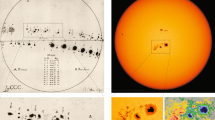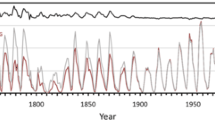Abstract
Recently Clette et al. (Space Sci. Rev. 186, 35, 2014) completed the first revision of the international sunspot number SSN(V2) since its creation by Wolf in 1849 SSN(V1) starting in 1700 and ending in May 2015. The yearly values of SSN(V2) are larger than those of SSN(V1) but the secular trend in their timelines both exhibit a gradual descent after Cycle 21 minimum resulting in greatly reduced activity for Cycle 24. It has two peaks; one in 2012 due to activity in the north hemisphere (NH) and the other in 2014 due to excess activity in the south hemisphere (SH). The N–S excess of hemispheric SSNs is examined for 1950 – 2014, in relation to the time variations of the solar polar field for 1976 – 2015, covering five complete solar cycles (19 – 23) and parts of the bordering two (18, 24). We find that SH tends to become progressively more active in the declining phase of the cycles reaching an extreme value that gave rise to a second higher peak in October 2014 in the smoothed SSNs accompanied by a strong solar polar field in SH. There may be a Gleissberg cyclicity in the asymmetric solar dynamo operation. The continuing descent of the secular trend in SSNs implies that we may be near a Dalton-level grand minimum. The low activity spell may last well past 2060, accompanied by a stable but reduced level of the space weather/climate. Fourier spectrum of the time domain of SSNs shows no evidence of the 208 year/cycle (ypc) (DeVries/Suess cycle) seen in the cosmogenic radionuclide (\({}^{10}\mathrm{Be}\)) concentration in the polar ice cores and \({}^{14}\mathrm{C}\) record in trees indicating that 208 ypc peak may be of non-solar origin. It may arise from the climate process(es) that change(s) the way radionuclides are deposited on polar ice. It should be noted that we only have \({\sim}\,400~\mbox{years}\) of SSN data, so it is possible that DeVries/Suess cycle is really driven by the Sun but for now we do not have any evidence of that; there is no known physical process linking 208 ypc to solar dynamo operation.






Similar content being viewed by others
References
Ahluwalia, H.S.: 2000, Ap time variations and interplanetary magnetic field intensity. J. Geophys. Res. 105, 27481. DOI .
Ahluwalia, H.S.: 2003, Meandering path to solar activity forecast for cycle 23. In: Velli, M., Bruno, R., Malra, F. (eds.) Solar Wind Ten: Proc. Tenth Int. Solar Wind Conf., AIP: CP679, 176.
Ahluwalia, H.S.: 2013, Sunspot numbers, interplanetary magnetic field, and cosmic ray intensity at Earth: nexus for the twentieth century. Adv. Space Res. 52, 2112.
Ahluwalia, H.S.: 2014, An empirical approach to predicting the key parameters for a sunspot number cycle. Adv. Space Res. 53, 568.
Ahluwalia, H.S.: 2015, North–South excess of hemispheric sunspot numbers and cosmic ray asymmetric solar modulation. Adv. Space Res. 56, 2645.
Ahluwalia, H.S.: 2016, The descent of the solar cycle 24 and future space weather. Adv. Space Res. 57, 710.
Ahluwalia, H.S., Jackiewicz, J.: 2011, Sunspot cycle 24 ascent to peak activity: a progress report. In: Proc. 32nd Int. Cosmic Ray Conf. 11, 232.
Ahluwalia, H.S., Jackiewicz, J.: 2012, Sunspot cycle 23 descent to an unusual minimum and forecasts for cycle 24 activity. Adv. Space Res. 50, 662.
Ahluwalia, H.S., Ygbuhay, R.C.: 2012, Sunspot cycle 24 and the advent of Dalton-like minimum. Adv. Astron. Article ID 126516. DOI .
Bartels, J.: 1962, Collection of Geomagnetic Planetary Index Kp and Derived Daily Indices Ap and Cp for the Years 1932–1961, North-Holland, New York.
Bray, R.J., Loughhead, R.E.: 1965, Sunspots, Barnes & Noble, New York.
Cini Castagnoli, G., Bonino, G., Provenzale, A.: 1989, The 206-year cycle in tree ring radiocarbon data and in the thermo-luminescence profile of a recent sea sediment. J. Geophys. Res. 94, 11971.
Clette, F., Svalgaard, L., Vaquero, J.M., Cliver, E.W.: 2014, Revisiting the sunspot number: a 400-year perspective on the solar cycle. Space Sci. Rev. 186, 35. DOI .
Cole, T.: 1973, Periodicities in solar activity. Solar Phys. 30, 103.
De Jager, C., Duhau, S.: 2012, Sudden transitions and grand variations in the solar dynamo, past and future. J. Space Weather Space Clim. 2, A07, 8 pp. DOI .
Du, Z.L.: 2006, A new solar activity parameter and the strength of 5-cycle periodicity. New Astron. 12, 29.
Eddy, J.A.: 1976, The Maunder minimum. Science 192, 1189.
Eddy, J.A.: 1981, Climate and the role of the sun. In: Rotberg, R.I. Rabb, T.K. (eds.) Climate and History: Studies in Interdisciplinary History, Princeton University Press, Princeton, 145.
Frick, P., Galyagin, D., Hoyt, D.V., Nesme-Ribes, E., Schatten, K.H., et al.: 1997, Wavelet analysis of solar activity recorded by sunspot groups. Astron. Astrophys. 328, 670.
Friedli, T.K.: 2016, Sunspot Observations of Rudolf Wolf from 1849–1893. Solar Phys. DOI .
Gleissberg, W.: 1939, A long periodic fluctuation of the sunspot numbers. Observatory 62, 158.
Gnevyshev, M.N., Ohl, A.I.: 1948, On the 22-year solar activity cycle. Astron. Zh. 25, 18.
Kane, R.P.: 2008, Prediction of solar cycle 24 based on the Gnevyshev–Ohl–Kopecky rule and the three-cycle periodicity scheme. Ann. Geophys. 26, 3329.
Lockwood, M.: 2010, Solar change and climate: an update in the light of the current exceptional solar minimum. Proc. Roy. Soc. Edinb. A 466, 303. DOI .
MacDonald, G.J.: 1989, Spectral analysis of the time series generated by nonlinear processes. Rev. Geophys. 27, 440.
Mayaud, P.N.: 1972, The aa indices: a 100 year series characterizing the magnetic activity. J. Geophys. Res. 77, 6870.
Mayaud, P.N.: 1973, A Hundred Year Series of Geomagnetic Data, 1868–1967, IAGA Bull. 33, Int. Union of Geod. and Geophys, Paris.
Mayaud, P.N.: 1980, Derivation, Meaning, and Use of Geomagnetic Indices, Geophysical Monograph 22, Am. Geophys. Union, Washington.
McCracken, K.G., Beer, J., Steinhilber, F., Abreu, J.: 2014, The heliosphere in time. Space Sci. Rev. 176, 59.
Murakőzy, J., Ludmány, A.: 2012, Phase lags of solar hemispheric cycles. Mon. Not. Roy. Astron. Soc. 419, 3624. DOI .
Peristykh, A.N., Damon, P.E.: 2003, Persistence of the Gleissberg 88-year cycle over the last \({\sim}\,12000\) years: evidence from cosmogenic isotopes. J. Geophys. Res. 108, A1. 15 pp.
Petrovay, K.: 2010, Solar cycle prediction. Living Rev. Solar Phys. 7, 5.
Silverman, S.M.: 1992, Secular variation of the aurora for the past 500 years. Rev. Geophys. 30, 333.
Steinhilber, F., Beer, J.: 2013, Prediction of solar activity for the next 500 years. J. Geophys. Res. 118, 1861.
Svalgaard, Y., Kamide, Y.: 2013, Asymmetric solar polar field reversals. Astrophys J. 763(1). Article id. 23, 6 pp.
Vernova, E.S., Tyasto, M.I., Baranov, D.G.: 2014, Photospheric magnetic field: relationship between North–South asymmetry and flux imbalance. Solar Phys. 289, 2845.
Yoshimura, H.: 1979, The solar cycle period-amplitude relation as evidence of hysteresis of the solar cycle magnetic oscillation and the long-term (55 year) cyclic modulation. Astrophys. J. 227, 1047.
Zharkova, V.V., Shepherd, S.J., Popova, E., Zharkov, S.I.: 2015, Heartbeat of the sun from principal component analysis and prediction of solar activity on a millennium timescale. Sci. Rep. 5, 15689. DOI .
Acknowledgements
We thank Frédéric Clette for sharing the hemispheric sunspot number data, Laure Lefèvre for comments on the Greenwich photographic results starting in 1874, and the reviewer for two references and helpful comments.
Author information
Authors and Affiliations
Corresponding author
Ethics declarations
Disclosure of Potential Conflicts of Interest
The authors declare that they have no conflicts of interest.
Rights and permissions
About this article
Cite this article
Ahluwalia, H.S., Ygbuhay, R.C. Salient Features of the New Sunspot Number Time Series. Sol Phys 291, 3807–3815 (2016). https://doi.org/10.1007/s11207-016-0996-9
Received:
Accepted:
Published:
Issue Date:
DOI: https://doi.org/10.1007/s11207-016-0996-9




